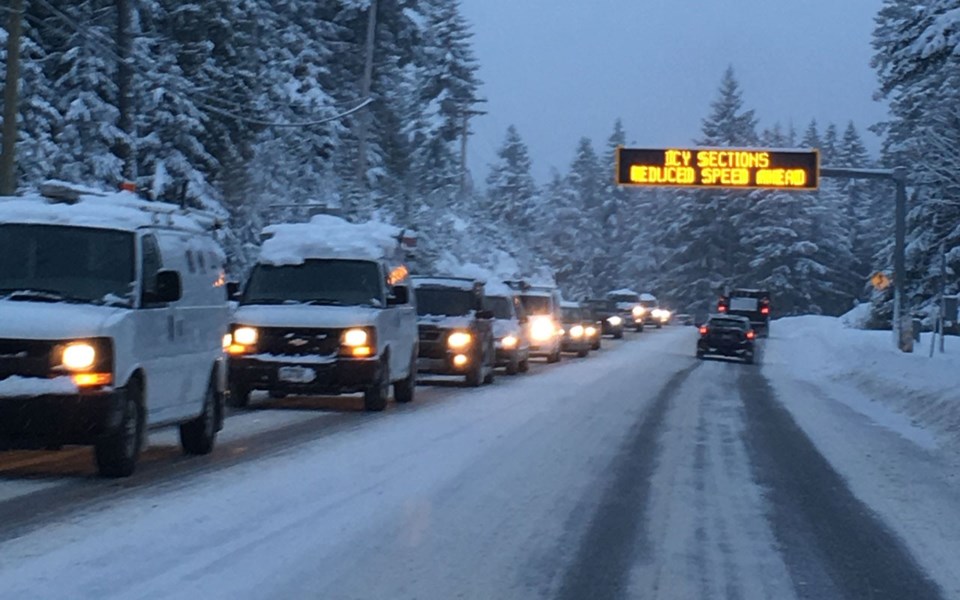We haven't seen the types of highway traffic jams or frustration with parking or uploading onto the mountains, as we saw in the last couple of weeks, for a while now.
Much of it can be laid at the feet of Mother Nature as we finally enjoyed some significant snowfall in the resort.
But some of those frustrations come right out of human behaviour—such as people still driving without proper tires or the experience to handle the conditions—and let's throw in a U.S. long weekend too.
And simple math dictates that long waits will be the reality when thousands flock to the four valley ingress points to both Whistler and Blackcomb mountains to try to enjoy powder after a veritable drought in December.
Sadly, these frustrating experiences just result in people venting on social media, complaining to Whistler Blackcomb, and generally being very unhappy visitors to our resort.
This is nothing new—for years, the pages of Pique have been filled with stories about these types of issues with people voicing concern that we are suffering overtourism. In 2017, concerns over highway-traffic congestion lead to the re-formation of the Transportation Advisory Group.
In November of that year, five strategy areas were highlighted: Highway 99 efficiencies, transit improvements, better parking management, active transportation options and "other."
Part of that plan was to pursue a regional transit strategy (estimated to cost $3.31 million) with corridor and government partners—the hope being to get more buses on the road. In a shortsighted move, the province said this past summer that from its perspective the plan was not feasible.
Just a few weeks ago, we learned of the work that Tourism Whistler (TW) has been doing aimed at defining what truly makes Whistler special and charting the long-term vision and strategy for "ideal tourism" into the future. The results are meant to guide not just TW's marketing, by targeting guests who best match Whistler's community values and interests, but also to "provide a filter" for local businesses and policy makers to help guide decision-making on things like programming and infrastructure investment.
If you like, it is turning our minds to the type of visitor who would best enjoy Whistler and its surrounds and come back, and tell their friends.
It could be that many of those stuck on the highway recently were Epic Day Pass holders—Vail Resorts introduced this pass here last year. It allows you to ski for as little as one day for a discounted price with the deal getting better the more days you buy. This helped replace the old one-day Whistler Blackcomb (WB) Edge cards, which many people from the Lower Mainland bemoaned the loss of. Losing day-pass options like this made WB too expensive for casual skiers, they said.
There can be little doubt that the experience many of the visitors had recently is exactly the type of experience TW is trying to avoid in highlighting our place branding.
But these things are not fully within our control—you simply can't let people flood onto the mountain when there are safety concerns.
Really, there are no easy fixes for these experiences by our guests.
One ski area, Washington state's Crystal Mountain, took an extreme step earlier this month to protect the experience of its snow sliders both on the mountain and off—it limited its ticket sales.
In the case of Crystal Mountain, the resort's COO and president Frank DeBerry said in an open letter to the ski and boarding community: "We are especially regretful to those who attempted to ski or ride with us and were turned around or were severely delayed. It is not what we want our guests or our community to feel. We've heard your frustration through a steady stream of emails, phone calls, and social media posts."
After taking time to "deconstruct the last several weekends of this overcrowding," DeBerry wrote, the resort will "discontinue selling walk-up tickets at the ticket booths on weekends and holidays in order to hold skier visits to what our roads and parking infrastructure is designed to handle."
Our mountains have huge capacity—the hourly lift capacity is 69,939 (on both mountains), there are 200 trails and 8,171 skiable acres—but sometimes it doesn't feel like it when you are standing in line for over an hour to upload.
Our highway carries an average of 11,733 cars daily to Whistler, its capacity apparently 1,650 cars per hour. It should be noted that when the $600 million upgrade was done, the province predicted we would reach 12,000 cars a day by 2025. Clearly we are well ahead of that schedule.
Are there lessons to be learned from Crystal Mountain's action? Should we consider, for example, taking a page out of a resort like Disney, where tickets are time stamped for use?
Maybe last weekend's mess doesn't happen often enough for us to worry about it, or maybe we should be thinking outside the box to protect the visitor experience when our experience tells us we are heading for a perfect storm of overtourism.




